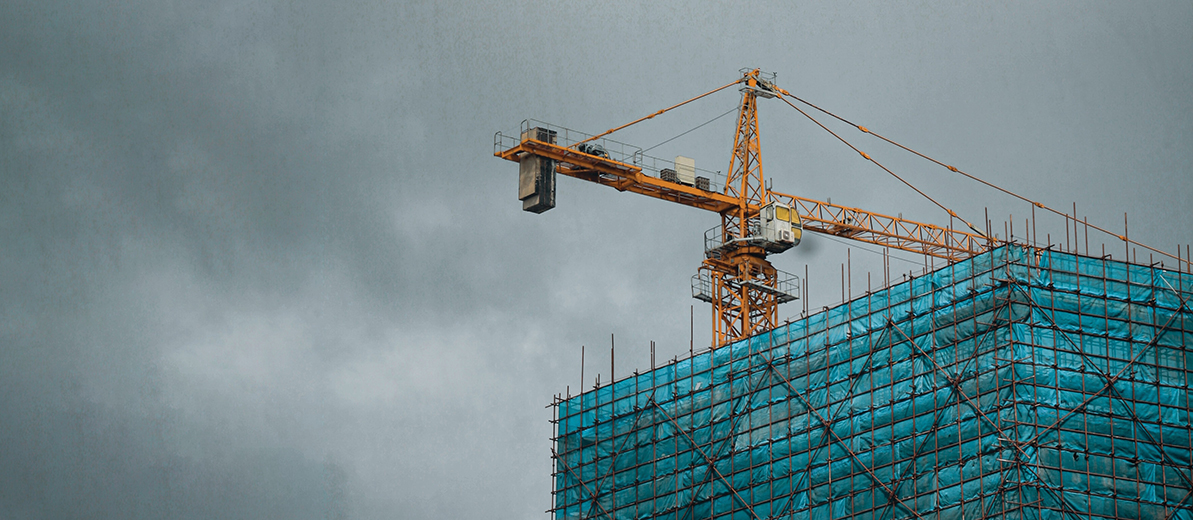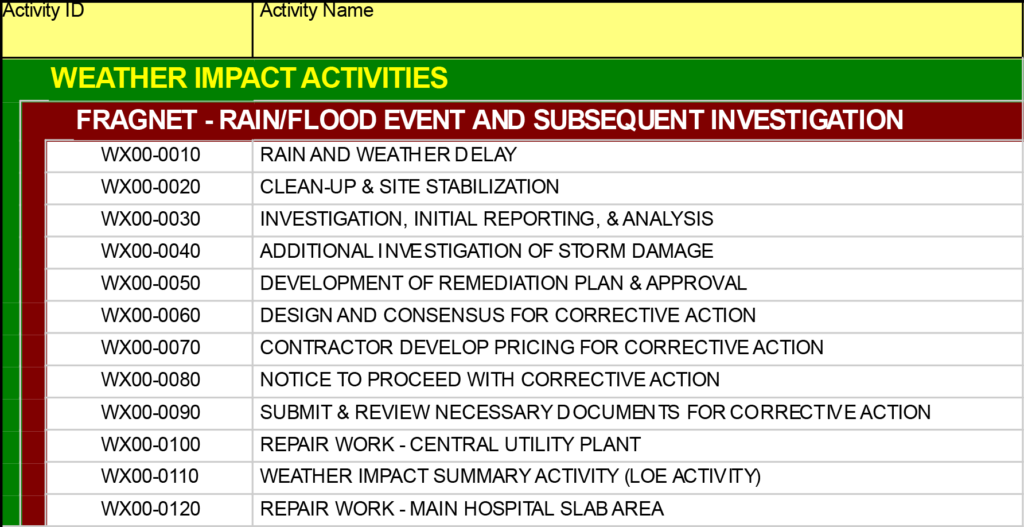
August 28, 2023
Force Majeure Delay Claim during the Construction of a New Hospital
Significant rainfall impacted the construction of a four-story, 350,000 square foot hospital and physician’s office building in Colorado. As part of the builder’s risk and delay claim, a delay analyst performed a time impact analysis to determine the extent of the schedule delay caused by the force majeure event.
In the early stages of masonry construction and structural steel erection, the project site experienced heavy rainfall for several consecutive days. In one week, precipitation in the area exceeded five times the average rainfall for the month. The excessive rain created more runoff and site drainage than anticipated by the civil design engineers. The runoff flooded the hospital slab on grade, and water infiltrated the structural column locations, lower slab elevations, and elevator pits. In certain locations, the slab on grade collapsed as much as three inches. In other locations, water infiltration washed out squeegee fill material and damaged the underground piping and electrical conduits. In addition to the hospital area, portions of the site had damage due to the rainfall and required remediation.
The general contractor teamed with the owner, insurance carriers, design engineers (geotechnical and structural), relevant subcontractors, and schedule delay consultant to determine the necessary steps for remediation and preparation of the insurance claim.
Original Construction Sequence
For purposes of planning and construction, the critical path method (CPM) schedule for the hospital was divided into five main structural areas: north, central, south, physician’s office building, and central utility plant (CUP).1 The original schedule planning included developing interior and exterior key plans to show the different areas within the hospital and the various elevations for exterior panel installation. The CPM schedule was set up with activity coding that corresponded to the area designations on the key plans. The early planning and setup of the baseline schedule and related documents proved to be a vital aspect in the schedule mitigation efforts and preparation of the hospital delay claim.
After site work, hospital construction was scheduled to begin with foundations, utilities, and slab on grade in the north and central areas, followed by structural steel erection. Two large cranes were on site to erect the structure in these areas simultaneously. The completion of one level of steel for a given area and level was linked to installation of the metal deck and concrete topping slab. Upon completion of the topping slab in an area, the steel under the deck could be fireproofed. After the perimeter building beams were fireproofed, exterior panels could be erected.
Following steel erection in the north and central areas, the cranes would be repositioned to erect steel in the south hospital area and office building.
After an area was dried in,2 the interior buildout of each area of the hospital was scheduled to begin with layout and framing of priority walls.3 These activities were sequenced with soft logic, or crew logic, based on the number of crews available. The framing subcontractor intended to provide two framing crews, and the schedule was set up for these crews to work concurrently. Because successor building trades were linked to construction of priority walls, the other building trades were scheduled based on the sequence of the priority walls. The sequence of construction of the interior areas was linked in the schedule to flow from the north interior areas to the south interior areas.4
The construction of the central utility plant was scheduled concurrent with the construction of the utilities and slabs in the main hospital area. The work in the central plant was scheduled independent of the work in other areas of the hospital and office building, and a small crane was on site for work specific to the central plant. However, completion and testing of the plant was required to be completed prior to testing and commissioning of the hospital and office building.
Revised Construction Sequence Due to Force Majeure Delay
Due to the mitigation required for the slab on grade and underslab utilities, the sequence of construction was modified such that interior buildout on floors two through four could be progressed concurrent with the mitigation work occurring at the ground level.
Generally, the changes to the construction sequences occurred with the installation of exterior panels and the construction of priority walls. In the original schedule, the exterior panel activities were successor activities to the fireproofing activity in the same area. However, because of the slab mitigation on the first level, fireproofing activities would be complete prior to completion of the slab mitigation. Therefore, the exterior elevation work was linked to completion of the slab mitigation.
As discussed above, the interior build-out sequence was based on the construction of priority walls. Due to the mitigation required on the ground level, the schedule logic was revised such that the priority wall crews would begin on the second level of the building and work through the second level and then work floors three and four, respectively. After completion of level four, the crews would return to the ground floor. The CPM schedule logic for the priority wall crews was adjusted to reflect this workflow. Because the schedule had been originally set up such that the building trade work on floors two through four was based on the sequence of prior walls, additional soft logic (crew logic) changes were not necessary.
Schedule Delay Analysis and Claim Preparation
For the preparation of the delay analysis, a time impact analysis was selected as the best methodology to model the force majeure delay and the associated delay to the completion and turnover of the hospital. The schedule was updated to reflect actual progress immediately prior to the force majeure event. A copy of this schedule was then used to create the impacted schedule. To model the impact, a schedule fragnet was prepared and inserted into the impacted schedule.5
Schedule Fragnet for Force Majeure Delay

In addition to the schedule fragnet, other schedule revisions were made as discussed earlier in this blog post. By this time in the claim process, the owner, contractor, and insurance adjustors had discussed and agreed on the fragnet activities and recommended changes to the schedule. Communication between the parties and full transparency on the changes to the schedule and the constructability reasons for those changes greatly facilitated this process.
The delay analyst prepared a full claim package, which included the updated schedule (pre-delay), impacted schedule, detailed schedule narrative, descriptions of the critical paths before and after the delay event, and a full description of all changes made to the impact schedule. The key plans that were set up during the development of the baseline were an important aspect of the claim preparation, as these key plans could be used to describe the interior and exterior elevations in the schedule narrative.
The contractor was able to quickly resolve the claim with the insurance company. Several keys to the timely and positive resolution of the claim were early and frequent communications among all parties, as well as a good baseline schedule and updates, and a thorough and well-documented schedule analysis describing the delay and impacts to the construction schedule.
1 The utility plant may be referred to as the central energy plant, or CEP, in other hospital projects.
2 The dry-in milestone is an important construction milestone and refers to when an area is enclosed and no longer exposed to the elements.
3 A priority wall is a wall in which the drywall must be installed prior to HVAC, electrical, plumbing, and fire sprinkler infrastructure. This is necessitated by access restrictions to allow construction of utilities to continue after the installation of the drywall.
4 For purposes of this blog post, the construction sequencing is described in a very high-level and general manner.
5 Additional fragnets were developed for each slab repair activity shown in the figure. The activities within each of these fragnets were for construction work pertaining to: sawcut and demolition of concrete, subgrade remediation (including utilities), drill/epoxy dowels, set rebar, install vapor barrier, place concrete, and moist cure of the concrete.
ADDITIONAL RESOURCES

Blog
Discover industry insights on construction disputes and claims, project management, risk analysis, and more.
MORE

Articles
Articles by our engineering and construction claims experts cover topics ranging from acceleration to why claims occur.
MORE

Publications
We are committed to sharing industry knowledge through publication of our books and presentations.
MORE
RECOMMENDED READS
Acts of God/Weather
Delays resulting from acts of God are normally excusable but noncompensable events in the absence of a contract clause stating otherwise.
READ
Definitions of Construction Claim Types for Contractors
The author summarizes the definitions of the 19 construction claim types that may apply to a contractor’s and subcontractor’s recovery of time and costs.
READ
Implementing Time Impact Analyses and Update Impact Analyses on Large, Complex EPC Projects
This article examines the various complexities in analyzing the schedule impact of multiple changes.
READ
